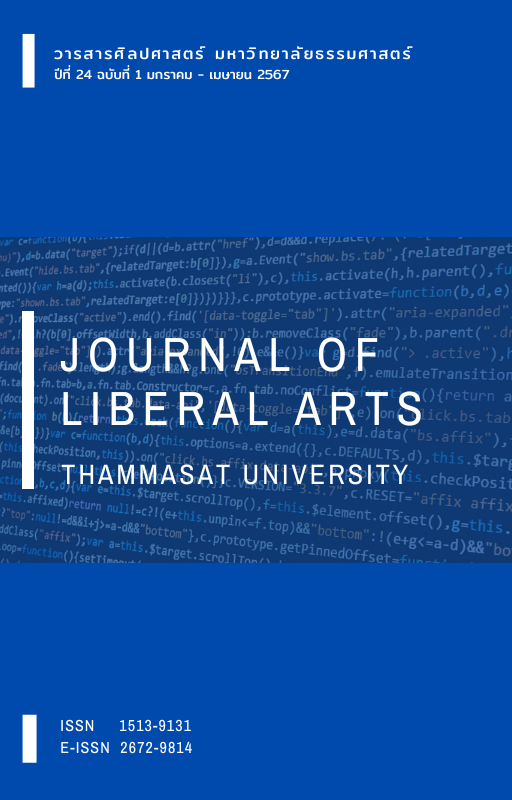Development of Tourism Routes with Spatial Configuration Analysis based on Local Cultural Ecology in the Koh Lad E-Tan Community, Nakhon Pathom
Main Article Content
Abstract
This article aims to develop of tourism route with spatial configuration analysis based on local cultural ecology in Koh Lad E-Tan community, Nakhon Pathom. The research uses theoretical concepts in urban morphology, Space Syntax analysis tools, and the analysis of social and cultural activities. Using a survey, non-participatory observation, and in-depth interviews, the study found that the three tourist routes are combinations of land and water: Route A emphasizes lifestyle and knowledge; Route B concentrates on culture and architecture; and Route C concentrates on geography and environment. The article provides suggestions to consider the territory and level of access to the community's public areas, agricultural areas, and social areas, including the ability of the carrying capacity to preserve the characteristics of the local cultural ecology.
Downloads
Article Details

This work is licensed under a Creative Commons Attribution-NonCommercial-NoDerivatives 4.0 International License.
References
การท่องเที่ยวแห่งประเทศไทย. (2561). การท่องเที่ยวโดยชุมชมอย่างยั่งยืน. TAT review magazine. https://tatreviewmagazine.com/article/cbt-thailand/
จุฬาลงกรณ์มหาวิทยาลัย, คณะสถาปัตยกรรมศาสตร์. (2538). คู่มือพัฒนาภูมิทัศน์เมืองเพื่อการท่องเที่ยว. จุฬาลงกรณ์มหาวิทยาลัย.
ฐปณี รัตนถาวร และ พรชัย จิตติวสุรัตน์. (2564), กระบวนการเกิดสัณฐานศูนย์กลางของชุมชนตลาดริมน้ำลำพญา ลุ่มน้ำนครชัยศรี จังหวัดนครปฐม. วารสารศิลปศาสตร์ มหาวิทยาลัยธรรมศาสตร์, 21(2), 379-408. https://doi.org/10.14456/lartstu.2021.31
นุชนารถ รัตนสุวงศ์ชัย. (2554). กลยุทธ์การพัฒนาการท่องเที่ยวเชิงวัฒนธรรม. วารสารมนุษยศาสตร์วิชาการ, 18(1), 31-50. https://so04.tci-thaijo.org/index.php/abc/article/view/54197/44987
บุญเลิศ จิตตั้งวัฒนา. (2548). การพัฒนาการท่องเที่ยวแบบยั่งยืน. เพรส แอนด์ ดีไซน์.
วิมลสิทธิ์ หรยางกูร. (2542). พฤติกรรมมนุษย์กับสภาพแวดล้อม: มูลฐานทางพฤติกรรมเพื่อการออกแบบและวางแผน. สำนักพิมพ์แห่งจุฬาลงกรณ์มหาวิทยาลัย.
ศิริภา มณีรัตน์ และ จุฑาทิพย์ เฉลิมผล. (2560). รูปแบบการจัดการท่องเที่ยวเชิงเกษตรที่เหมาะสมของเส้นทางสายแม่ริม-สะเมิง อำเภอแม่ริม จังหวัดเชียงใหม่. แก่นเกษตร, 45(พิเศษ1), 540-544.
สัญญา สัญญาวิวัฒน์. (2551). ทฤษฎีและกลยุทธ์การพัฒนาสังคม. สำนักพิมพ์แห่งจุฬาลงกรณ์มหาวิทยาลัย.
สำนักพัฒนาแหล่งท่องเที่ยว. (ม.ป.ป.). คู่มือการประเมินมาตรฐานคุณภาพแหล่งท่องเที่ยวเชิงเกษตร (พิมพ์ครั้งที่ 2). สืบค้นเมื่อ 24 เมษายน, 2566, จาก https://chainat.mots.go.th/ewt_dl_link.php?nid=788
สิงห์อำพล จันทร์วิเศษ, พิชัย ทองดีเลิศ, และ ชลาธร จูเจริญ. (2564). ความต้องการในการพัฒนาท่องเที่ยวเชิงเกษตรของเกษตรกรในพื้นที่เกาะลัดอีแท่น อำเภอสามพราน จังหวัดนครปฐม. วารสารแก่นเกษตร, 49(5), 1160-1170.
อนุกูล ตันสุพล. (2559). นิเวศวิทยาวัฒนธรรม : กุญแจสู่การพัฒนาที่ยั่งยืน. วารสารวิชาการคณะมนุษยศาสตร์และสังคมศาสตร์, 12(1), 193-221.
Al Sayed, K., Turner, A., Hillier, B., Iida, S., & Penn, A. (2014). Space syntax methodology. The Bartlett School of Architecture, UCL.
Arif, Y. M., Putra, D. D., & Khan, N. (2023). Selecting tourism site using 6 As tourism destinations framework based multi-criteria recommender system. Applied Information System and Management (AISM), 6(1), 7-12. https://doi.org/10.15408/aism.v6i1.25140
Collier, A., & Harraway, S. (1997). Principles of tourism. Longman Paul.
Denzin, N. K. (2009). The Research Act: A Theoretical Introduction to Sociological Methods. Routledge. https://doi.org/10.4324/9781315134543
Ding, J., Gao, Z., & Ma, S. (2022). Understanding social spaces in tourist villages through space syntax analysis: Cases of villages in Huizhou, China. Sustainability, 14(19), 12376. https://doi.org/10.3390/su141912376
Goeldner, C. R., & Ritchie, J. R. B. (2012). Tourism: Principles, practices, philosophies. (12th ed.). John Wiley & Sons.
Hillier, B., & Hanson, J. (1984). The social logic of space. Cambridge University Press.
Hillier, B. (1996). Cities as movement economies. Urban Design International, 1, 41-60. https://doi.org/10.1057/udi.1996.5
Hillier, B. (2000). Centrality as a process: Accounting for attraction inequalities in deformed grids. Urban Design International, 3(4), 107-127. https://doi.org/10.1080/135753199350036
Hillier, B., Penn, A., Hanson, J., Grajewski, T., & Xu, J. (1993). Natural movement: Or, configuration and attraction in urban pedestrian movement. Environment and Planning B: Planning and Design, 20(1), 29-66. https://doi.org/10.1068/b200029
Koster, E. H. (1996). Science culture and cultural tourism. In M. Robinson, N. Evans, & P. Callaghan (Eds.), Tourism and cultural change: Tourism and culture towards the 21st century (pp. 227-238).The Center for Travel and Tourism and Business Education.
McDonagh, D. (2008). Do it until it hurts!. Design Principles and Practices An International Journal—Annual Review, 2(3), 103-110. https://doi.org.10.18848/1833-1874/CGP/v02i03/37554
Moulin, C. M. (1991). Cultural heritage and tourism development in Canada. Tourism Recreation Research, 16(1), 50-55. https://doi:10.1080/02508281.1991.11014602
Boonkham, P. (2011). Landscape urbanism - A concept for new era city. Journal of Government Housing Bank, 17(65), 43-47.
Rapoport, A. (1977). Human aspects of urban form: Towards a man-environment approach to urban form and design. Pergamon Press.
Turner, A., & Penn, A. (1999). Making isovists syntactic: Isovist integration analysis. In Universidad de Brasilia, Proceedings of the 2nd International Symposium on Syntax (pp. 01.1-01.9). https://www.spacesyntax.net/symposia-archive/SSS2/SpSx%202nd%20Symposium%2099%20-2003%20pdf/2nd%20Symposium%20Vol%201%20pdf/11%20Turner%20300.pdf
UNESCO (2006). Tourism, culture, and sustainable development. http://unesdoc.unesco.org/images/0014/001475/147578E.pdf

